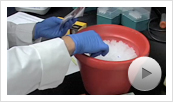Can I detect a protein expressed in the TnT® Coupled in vitro Transcription/Translation System using Coomassie® blue-stained SDS-PAGE?
To detect a single protein, one commonly used method is to add a labeled amino acid (e.g.,
[35S]Methionine) to the TnT® reaction to be incorporated into the synthesized protein followed by detection using SDS-PAGE and autoradiography. Alternatively, non-radioactive protein-labeling methods can be used such as the Transcend™ tRNA or FluoroTect™ GreenLys in vitro Translation Labeling System. With the Transcend™ Non-Radioactive Labeling System, biotinylated lysine is incorporated into the newly synthesized proteins and detected by colorimetric (Cat.# L5070) or chemiluminescent (Cat.# L5080) methods after Western blotting (see Technical Bulletin #TB182 for more details). The FluoroTect™ Labeling System (Cat.# L5001) uses a modified lysine tRNA charged with BODIPY®-FL to fluorescently label proteins. The BODIPY®-FL-labeled protein can be directly detected "in gel" using a laser-based fluorescent scanner (see Technical Bulletin #TB285 for details). All three labeling techniques can detect proteins in the 0.5–5 ng range.
Furthermore, there are other methods that can be used to detect proteins expressed using the TnT® Coupled Transcription/Translation Systems. If an appropriate antibody is available, the protein of interest may be detected using Western blotting. Depending upon the protein, the expressed protein activity can be measured using an enzymatic or functional assay.
Related Resources
Coomassie is a registered trademark of Imperial Chemical Industries, Ltd.
Products may be covered by pending or issued patents or may have certain limitations on use.
 Quick, easy cell-free protein expression with T
Quick, easy cell-free protein expression with T